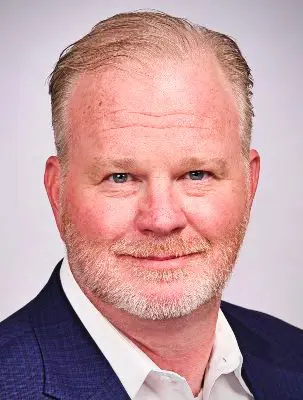Cisco took time out with Enterprise IoT Insights at MWC a couple of weeks back to discuss its late entry into the private 5G market, plus its channel strategy around system design and network support, and partner strategy around radio access network (RAN) components. The biggest takeaway, perhaps, is its focus on Wi-Fi-like simplicity, which will work for its sales channel, and Wi-Fi-friendly play, which will work for its enterprise customers, it reasons.
The company has shrunk-down and “shrink-wrapped” its 5G macro core, as used by various national carriers, for private installations in enterprise premises. These edge deployments will invariably use privately licensed spectrum; but Cisco suggested the commonality with certain wide-area core deployments will, in time, also bring value for enterprises looking to put 5G-based IoT use cases ‘on the road’, to run between private and public networks.
“We have, since 2013, a very well deployed commercial-grade core [with operators] throughout the world. So we know and trust and understand that technology. We haven’t gone off and built it again; we are using a technology we own and know, which we have right-sized for enterprises… When you start to move from private into macro, we can anchor devices in the same core [with] the same technology running in both the enterprise and [operators].”
So says Ian Campbell, the company’s chief tech officer for mobility; the obvious application he suggests, is with connected cars, “moving from a factory into a broader network with the same SIM”. It is an interesting theory, which crosses into future scenarios around advanced IoT in public-network slices. But the real intrigue in Cisco’s offer, as it stands, is with its sales strategy, and its arguably-defensive, but entirely-logical, position to cross-sell 5G to major clients.

“Given how many customers Cisco has, there’s definitely [an element of that]… [But] 5G on its own for enterprises, or private 5G on its own, is not how this is going to work. Other access tech – Wi-Fi, LoRa, all those things – will help to meet the broader demand, especially among large enterprises. Some green-fields will go just with 5G, but most are bringing 5G into existing environments. It is never going to be 5G-only; 5G is only a way to augment what already exists.”
It is the same line, naturally, about dovetailing with existing (mostly Wi-Fi) enterprise estates from rival HPE (see its parallel private 5G announcement here; check back for the late HPE-MWC write-up). A question goes to Campbell about how the two offers are different. “Yeah, it is a good question,” he responds. “It is a pretty saturated market; you can go really small [with rival offers], and also see [traditional] competitors like HP are coming out with this stuff.”
The implication, from their parallel marketing, is the mobile crowd tends to overplay 5G as a panacea for new-age enterprise networking. So what is the difference with HPE, because its messaging is similar? Campbell plays a straight bat. “Yes, it says the same thing, and claims its [private 5G] integrates with I-don’t-know-what in its portfolio. But it has certain areas and we have certain areas that will benefit.”
So, what gives? What makes the Cisco system special? “Our focus is on the SaaS aspect – simplicity, automation, and the facility for enterprises to manage their devices and networks in a dashboard. A lot of other solutions don’t have that ease-of-use. Plus, it ties into our broader portfolio – to exchange policies between the Wi-Fi and 5G networks, say, and to have a lot of the same tooling… so security goes under the same umbrella.”
It is perhaps hard to distinguish them still; the line about broader IT integration might be argued by HPE, as well. But for now, Cisco’s strategy looks more developed, arguably. The shrink-ray the firm put on its macro-core 5G is no mean feat, it is worth noting; Nokia, for one, tells of similar (historic) challenges to “right-size” 5G for industry. The result for Cisco is a box-solution that can be easily deployed (with careful radio planning) and configured in the cloud.
Campbell comments: “We piggybacked on that, and took the – let’s say – thousand-things a regular operator needs to configure and brought it down to a minimal set for an enterprise. We shrink-wrapped the entire solution to go on a single server, down from tens or hundreds of racks at an operator. All of that has required us to build a kind of simplification facade, to right-size it down for thousands of devices, instead of millions.”
But, again, its sales channel is its most interesting feature; with some radio knowhow, and “some training”, private 5G starts to look like something value-added resellers (VARs) can handle. (The idea that private 5G could be box-shifted, like phones and airtime, via the old telco dealer channel seems almost viable, too.) Cisco has appointed UK reseller Logicalis, plus others; operator DISH is also reselling its 5G system – in a move that, paradoxically, makes telcos into distributors, rather than operators.
Campbell says: “We are working with partners that can go in and set this up; to install radios, bring up an initial system, and connect back to our cloud – from where we automate the software install and enterprise configurations, including all the telemetry and KPI management. All that gets delivered-down and remotely-installed into the edge server in the enterprise – to be self-managed and self-operated via a scalable pay-as-you-go SaaS platform.”
As a detail, almost (in this narrative), Cisco has lined up JMA and Airspan as certified RAN partners, with more to follow. “Instead of a single radio vendor, or even building our own RAN, we are working with a handful of partners – we’ve announced two, and have an intent to broaden the ecosystem,” says Campbell. Cisco has hooked into their enterprise management systems, also – “so we know in the console if [the RAN] is up or down”.
Interestingly, RAN selection so far has been weighed on the relative strengths of the US duo. “Different radios for different environments,” explains Campbell. “JMA is very well suited for CBRS in the US; Airspan has SA assets that work very well. Each has its own areas of strength.” Does that mean, effectively, different geographies for different vendors? So that Airspan, by turn, is leading RAN-supply with Cisco in Europe and Asia, perhaps?
He responds: “I mean, yes, at this point in time, you could say that. It’s not really one radio per market, but at some level they do break down that way, based on where they are in their development – with regards to the different bands they support, and outdoor/indoor coverage. Those things determine how applicable they are for both the kind of network, and geography.”
What about the likes of Nokia and Ericsson, which offer competition for Cisco in the macro-core market – but which might claim a lead over certain others on private RAN for critical industry, for example? Is their absence, thus far, a strategic choice, either because of rivalry elsewhere, or because of a perceived lack of ‘openness’? Does Campbell expect Cisco’s channel partners to provision Nokia RAN for enterprises with its private 5G system?
“We are open to working with them in certain scenarios. We are not competitors [on RAN]; we work with them on the macro side, which is where most of our deployments are. So we have that integration already. It is more about hitting that commercial [remit on private 5G]… I think [JMA and Airspan] are more open; the wider open RAN ecosystem still has to achieve some technical maturity, but they do offer that openness, to make it a manageable solution.”
Back to the sales stuff. Cisco has a bunch of installations (Chaplin, Clair Global, Colt Technology, ITOCHU Techno-Solutions, Network Rail, Nutrien, Schaeffler Group, Texas A&M University, Toshiba, Zebra Tech); such work is divided between manual radio planning, carried out by the channel partner, and automated configuration and management, carried out by Cisco, in a management console in the cloud.
Campbell says: “Everything around site planning and hanging radios – based on the size of the venue, and whether it is indoors or outdoors, for example – is handled by partners. We need to know throughput, and device volumes, and the number of edge networks that will be deployed. The partner is responsible for bringing it up to day-zero, and [from there] we configure and provision, and allow for self-management.”
But there is more, invariably, to the channel support dynamic. “We are using the managed service provider or service provider channel to do the things we can’t manage – which means, you know, bringing up the RAN environment, and replacing an edge device, say, if it fails,” explains Campbell. This, then, goes further along the design-build-run chain, to get into managed service SLAs.
The question goes, again; put more directly: who, in the end, manages the private 5G estate? Who picks up the phone if critical infrastructure goes down? Campbell comes back: “Once the network is live, all the management is done in the cloud. If more capacity is required, then that is where we employ partners to help. In terms of the run-phase of operations, we do most of that. But there are scenarios as well where we need a partner to go onsite.”
For more on this topic, look out for the new editorial report and webinar session on industrial 5G (from setting standard to becoming standard) on April 28, featuring Phil Skipper, Head of IoT Business Development at Vodafone Business, Asimakis Kokkos, Chair of the Technical Specification Group at MFA (MUlteFire Alliance) and Head of Technology Ecosystems at Nokia, and Leo Gergs, Senior Analyst at ABI Research, among others. Sign up here for the session and report.

